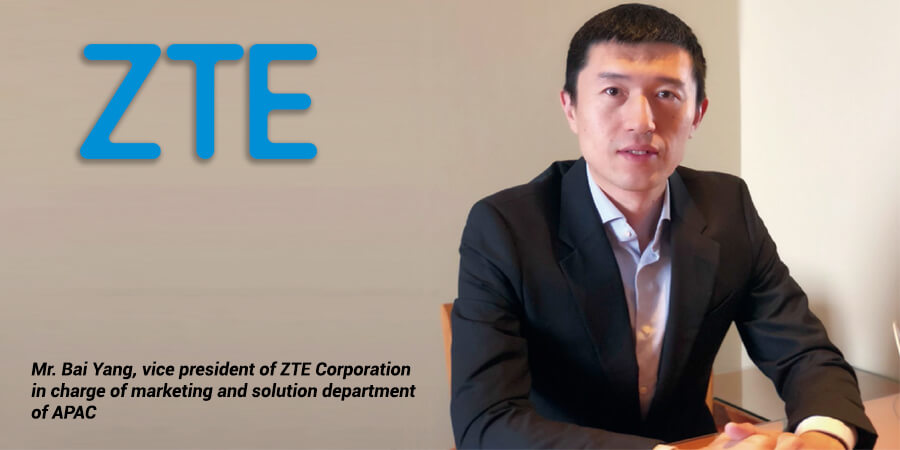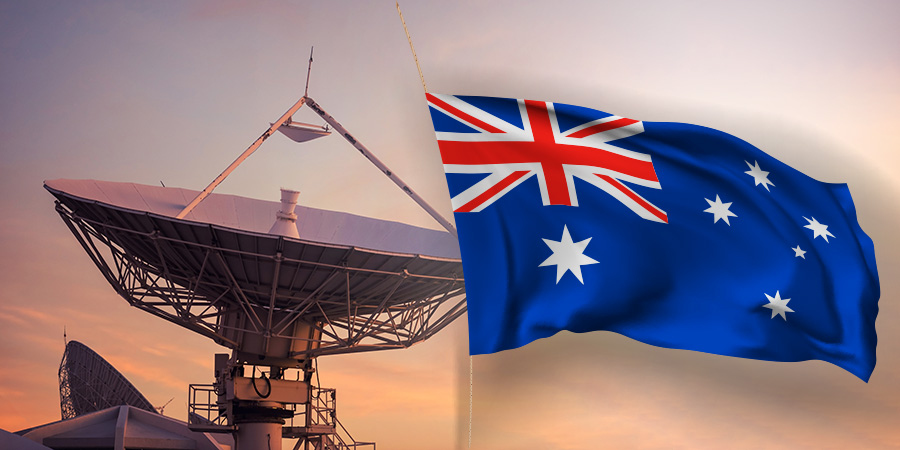
As digitalization becomes increasingly fundamental to Asia Pacific’s economic growth, Telecom Review Asia Pacific interviews Mr. Bai Yang, vice president of ZTE Corporation in charge of marketing and solution department of APAC to glean insights into ZTE’s innovations that help spearhead and support the region’s industry digitalisation.
What are the prospects and key drivers of Asia Pacific’s digital economy?
Asia-Pacific region is the fastest-growing digital economy in the world, with an annual growth rate of 7.7%. Digital economy has become a key driving force behind economic development. China, Vietnam, Indonesia, the Philippines and other countries have achieved impressive growth in their digital economy. The Asia-Pacific is a young and dynamic region with a huge digital economic potential. As per GSMA’s prediction, mobile subscribers will increase by more than 250 million and mobile internet subscribers will increase by near 700 million by 2025. More countries and people will benefit from the improvements in productivity and efficiency, and the booming of digital economy brought by the improved capabilities of mobile services and growth in mobile subscribers. The developing trend of the digital economy in the Asia-Pacific region will become more obvious. Traditional industries are accelerating their transformation and upgrading in digitalization, networking and intelligence, as the scale of the digital economy continues to expand.
Industrial digitization is the main developing direction of digital economy, and 5G mobile internet development is the foundation and driving force of industrial digitization development. Industrial digitalization involves many industries and fields. 5G is the core that connects various fields and technologies, and is the path leading to digital economy development. The communication network with 5G as its core can solve the problems emerging from telemedicine, work, and education during the epidemic for the present. In the long run, 5G will drive the rapid development of other infrastructures, promote the digitalization and intelligentization of various industries, and jointly build a new 5G ecosystem of cross-industry integration and innovation and extensive participation of the whole society.
5G development is not evenly distributed across APAC. How does ZTE navigate these differences to support 5G deployment and its applications?
The Asia-Pacific region is the world’s largest and most populous region, and the geographical environment, economic development and telecom policies vary greatly in different countries, which has led to the unbalanced development of communication networks and diverse needs. ZTE has complete 5G end-to-end product lines and integrated solutions in the telecommunications industry. By means of all series of wireless, wireline, services, devices and professional telecommunications services, the company is capable of flexibly satisfying the diversified requirements and pursuit for rapid innovations of different countries, different customers, and different development stages.
ZTE can provide wireless access solutions of full scenarios, frequency bands, and range. Full scenario means it can provide coverage solutions for dense urban areas, general urban areas, suburbs, indoors, hot streets, islands, high-speed rail tunnels and air routes. Full frequency band means it can support 700 MHz, 2.3 GHz, 2.6 GHz, 3.5 GHz, 4.9 GHz and other mainstream 5G frequency bands – it can match different 5G spectrum resources in different countries. Full range refers to multiple channel options such as 64, 32, 8, 4, 2, etc. For economically developed and densely populated areas, 64 channels of ultra-large-capacity devices can be selected; for general cities, 32 channels equipment can be selected, and for vast rural areas, they can choose 8, 4, or 2-channel cost-effective equipment. Operators can flexibly choose solutions and products according to their own 5G construction strategy to achieve cost-optimal network construction.
Some developing countries still have a large number of 4G network construction and capacity expansion needs. ZTE can provide Unisite+ solutions, which can accelerate co-site deployment of 2G, 3G, 4G and 5G with fewer devices. It supports 1.8GHz+2.1GHz+2.6GHz, 700MHz+800MHz+900MHz at the same time, as well as 5G AAU equipment that supports 4/5G common mode and NSA/SA, which can achieve 4G to 5G smooth upgrade. SuperDSS, the industry’s only tri-RAT dynamic spectrum sharing solution, can enable tri-RAT dynamic spectrum sharing of 2G/4G/5G and 3G/4G/5G. SuperDSS is an ideal way of enabling fast 5G deployment on legacy FDD bands and at the meantime offering legacy voice service experiences, so as to maximize spectrum return on investment.
Besides, ZTE can provide 5G common core solution, which is a fully-converged core network solution meeting full access of 2G/3G/4G/5G/fixed networks that can save investment for operators. ZTE‘s precise 5G transport network solution can meet 5G’s full-cycle needs from small-scale network construction to full coverage. The hardware platform can meet the 5G capacity requirements in the next five years.
Based on these, ZTE has pioneered the industry’s first 5G end-to-end network slicing solution, and has led the 3GPP to successfully establish a 5G slicing enhancement project to realize one network for thousands of industries, and helps operators to provide vertical industries with differentiated slices that are “agile, intelligent, open, and secure” through a physical 5G network to meet the diverse needs of different industries and scenarios for bandwidth and latency.
In a hyperconnected digital era, how is ZTE positioned to serve enterprises across industries as business demands evolve and grow?
ZTE has collaborated with customers and industry partners to build demonstration projects, precisely empowering the digital transformation of industries, by virtue of its precision cloud networks and empowerment platforms. In the third quarter of 2020, the company had cooperated with industry-leading customers, such as the Guangzhou branch of China Mobile, China Telecom, Fuzhou Metro, China Southern Power Grid, and China Baowu Steel Group to implement innovative 5G applications in transportation, power, mining, commercial complex and other fields. ZTE’s GoldenDB has become China’s first domestic financial transaction distributed database commercially used in the core service systems of large banks. It has also supported the commercial use of China’s first Distributed Database Joint Laboratory. Moreover, the company has commercialized its full-module data center solution and won the bidding for Tencent’s centralized purchase while its remote security office solution has been increasingly adopted by large enterprises.
Increasingly, telcos need to deliver more than just connectivity. How does ZTE partner telcos in targeting vertical industries?
On one hand, to meet the fragmented needs of the industry, we build a precise cloud network. Focusing on industry scenarios, ZTE realizes “cloud on demand” through distributed precision cloud, and “network and cloud synergy” through deterministic precision network, supplemented by minimal maintenance, global coordination, and end-to-end security, to develop an integrated solution of precision cloud and network, and joint operators and industry partners to carry out extensive business practices to accelerate industry innovations.
On the other hand, we need to build an empowering platform to form an industry component library with common core technical capabilities, as a platform to empower industry customers and ecological partners, lower the technical threshold, and make it easier to use and upgrade by our partners, to accelerate application innovation and ecological construction. In this scenario, we have built capability components such as big video, big data, IoT, industrial control and telecommuting. All of these capability components can be opened to our partners, allowing rapid innovation application and achieving agile iteration according to industry scenarios.
Can you cite use cases of ZTE’s innovative solutions in supporting industry digitisation?
ZTE and more than 500 industrial partners have jointly explored 86 innovative industrial 5G application scenarios.
In the smart port field, we have cooperated with Antwerp port to deploy the first large-scale 5G SA private network in Belgium and provide 5G applications in Antwerp port Europe’s second largest port, to build a 5G+ smart port together with industry partners. Together with the port of Antwerp and many well-known enterprises, we have realized the application of 5G technology in the industrial park.
The 5G SA network deployed in Antwerp covers ZTE 5G NR 3.5GHz 64T64R/8T8R and 700MHz base stations, adopting leading Massive MIMO technologies, 5G common core and end-to-end slice management system etc., as well as ZTE 5G mobile phones and data terminals. It not only features high speed and low delay, but also supports unique network slicing functionality, providing highly reliable networks for enterprises in the campus. The slice isolation feature and MEC function ensure that different enterprise data are isolated from each other and does not leave the campus, providing higher enterprise data security.
In the intelligent manufacturing field, ZTE’s Nanjing Binjiang manufacturing base led the new infrastructure development “make 5G with 5G” to include a 5G enterprise private network and a mobile edge computing platform. 5G+MEC machine vision platform, 5G+AI quality inspection, autonomous driving and automatic loading/unloading functions are deployed, which greatly improves production efficiency and reduces costs. Now in our factory, the production plant has been gradually unmanned through digital superimposition, smart warehouse, clouded AGV and machine vision. It is expected that by this year, the 5G production workshop will basically be fully unmanned.
Can you highlight strategic partnerships forged by ZTE in areas such as 5G and industry applications?
ZTE has established solid cooperation on 5G with important operators. In Europe, we are cooperating with Orange, Telefonica, Wind Tre, Open Fiber, Huchison Drei Austria, etc. In Asia, we have assisted Thai operators to complete the deployment and commercialization of more than 1,000 5G sites, and have signed 5G commercial contracts with operators in more than 10 countries including Indonesia, Malaysia, the Philippines, Pakistan, Myanmar, Belarus, Ukraine, and Uzbekistan and other countries, and will launch commercial 5G from 2021 to 2022.
Besides, ZTE and operators have already opted to work with industry partners. So far, ZTE and more than 500 industrial partners have jointly explored 86 innovative industrial 5G application scenarios, implemented 60 projects, and accumulated precious experience of 5G business model innovation. We have cooperated with industry-leading customers, such as Fuzhou Metro, China Southern Power Grid, China Baowu Steel Group, Tianjin Port, Antwerp port, and so on.
Moving forward, what are ZTE’s vision and strategies for revolutionizing industries in the region?
As the “road builder of digital economy”, ZTE will leverage our comprehensive advantages of “Device, Network, Cloud, and Platform”, explore data perception and application industry ecology widely, and adopt a modular solution approach to assist the industries flexibly. By providing the “ultimate networks“, “precision cloud-networks” and “empowering platforms”, ZTE and our partners promote the digital and intelligent transformation of thousands of industries and help the digital transformation of our society.
We have been expanding our footprint in the high-end market. Asia-Pacific is one of the highly dynamic communication investing regions, where ZTE has seized the opportunity to deploy 5G. We are cooperating with more operators in the Asia-Pacific region to replicate the successful industry applications and business models of 5G in China and Europe, and helping traditional industries with digital transformation to promote economic growth. This year, we will join operators and industry customers in the Asia-Pacific region to create some demonstration sites for 5G+ smart manufacturing and other applications. In the future, ZTE will continue to expand our ecological resources, work closely with global partners to deepen 5G innovations, and promote digital economy together with more 5G commercial successes.







